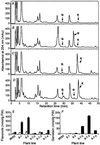Bottlenecks for metabolic engineering of isoflavone glycoconjugates in Arabidopsis
- PMID: 12384577
- PMCID: PMC137925
- DOI: 10.1073/pnas.212522099
Bottlenecks for metabolic engineering of isoflavone glycoconjugates in Arabidopsis
Abstract
In view of their perceived chemopreventive activities against hormone-dependent cancers, cardiovascular disease, and postmenopausal ailments, there is considerable interest in engineering plants to contain isoflavone phytoestrogens. However, attempts to date have only resulted in low levels of isoflavone accumulation in non-legumes. Introducing soybean isoflavone synthase (IFS) into Arabidopsis thaliana leads to accumulation of low levels of genistein glycosides. Leaves of wild-type A. thaliana contain high levels of similar conjugates of the flavonols quercetin and kaempferol, which could be increased by threefold on introduction of an alfalfa chalcone isomerase transgene. Levels of genistein were not increased by expressing both IFS and alfalfa chalcone isomerase, but levels of flavonol conjugates were reduced to a greater extent than could be accounted for by flux into isoflavone. Introduction of IFS into the tt6/tt3 double mutant blocked in flavonol, and anthocyanin synthesis resulted in high levels of genistein. The bottleneck for constitutive isoflavone production in Arabidopsis is, therefore, competition for flavanone between IFS and endogenous flavonol synthesis, and the flavonol pathway is reciprocally but disproportionately affected by IFS.
Figures





References
-
- Dixon R. A. (1999) in Comprehensive Natural Products Chemistry, ed. Sankawa, U. (Elsevier, New York), Vol. 1, pp. 773–823.
-
- Palevitz B. A. (2000) The Scientist 14, 8-9.
-
- Setchell K. D. R. & Cassidy, A. (1999) J. Nutr. 129, 758S-767S. - PubMed
-
- Lamartiniere C. A. (2000) Am. J. Clin. Nutr. 71, 1705S-1707S. - PubMed
-
- Adlercreutz M. (1998) Baillieres Clin. Endocrinol. Metab. 12, 605-623. - PubMed
Publication types
MeSH terms
Substances
LinkOut - more resources
Full Text Sources
Other Literature Sources
Molecular Biology Databases

